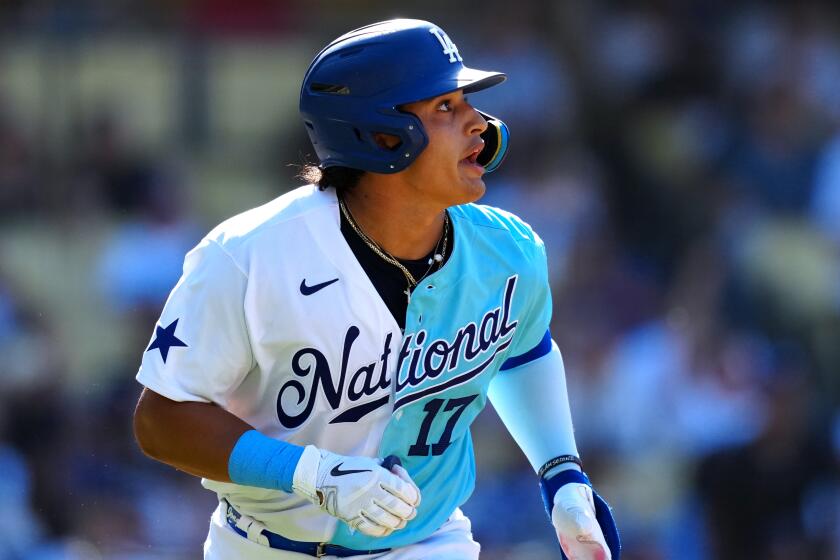Precautions Can Avert Deadly Risks of Heat
By taking precautions, such as frequent water breaks and practicing at cooler times of the day, football teams can prevent heat-related tragedies like the one that befell Korey Stringer of the Minnesota Vikings this week, medical and athletic training authorities say.
The All-Pro offensive lineman died Wednesday after he was stricken during workouts Tuesday in extreme heat and humidity at a training camp in Mankato, Minn.
“I cannot envision a situation in which someone should die from heatstroke and their need for rest and water not be recognized,” said Kevin Shannon, a pediatric cardiologist at UCLA Medical Center. “If the temperature is high or weather humid, they should have more breaks and water available.”
Deaths attributed to heatstroke among football players are rare, according to the National Center for Catastrophic Sport Injury Research at the University of North Carolina.
Four such deaths occurred nationwide in 2000--two each in college and high school--but they remain a concern. The most recent death in Southern California occurred in 1992, when a San Fernando High School player collapsed after conditioning practice and died two days later from the effects of heatstroke.
Sergio Echevarria, a 17-year-old senior who was trying out for the team for the first time, ran sprints in the early afternoon when the temperature reached 102 degrees. Although then-Coach Tom Hernandez cut practice short because of the heat, Echevarria collapsed about 30 minutes after running. He lapsed into a coma after suffering three seizures at the hospital.
Watching for Danger Signs
News of Stringer’s death brought back painful memories for Hernandez, now an assistant coach at San Fernando.
“I always know you can have an accident,” Hernandez said. “I know at any time a young kid can go down. . . . I get more scared [now]. You see a kid not feeling well, I pull him off [the field]. Every day we’re out here, you never know what’s going to happen.”
Years ago, football coaches routinely gave players salt pills and denied water at practice because that was believed to be the best way to toughen them for the season. But that’s no longer the case.
“Any coach who would purposefully put their kids in danger health-wise . . . that would be the highest form of negligence,” said Rob Wigod, assistant commissioner in charge of football for the Southern Section of the California Interscholastic Federation.
Long Practices in the Summer Sun
Early this month, the section will send each of its 520 high schools in Southern California a booklet that includes three pages dealing with heat stress and athletic participation. The information contains preventive measures to avoid heat exhaustion and heatstroke, including a list of air temperatures with relative humidities and how they relate to recommended duration for practice.
Southern Section teams are allowed 27 three-hour practices before the first games in early September, meaning players often spend long periods in the hot summer sun.
The same is true for football players in the Los Angeles City Section, which sent a bulletin of guidelines for preventing heat stress to each of its 60 high schools Wednesday.
“The bulletin is specific,” said Barbara Fiege, director of interscholastic athletics for the City Section. “At a certain temperature, activities should be curtailed.
“We have been lucky [with cooler temperatures this summer] up to this point. Certainly, any time something like [Stringer’s death] happens, we want to remind our people to take the proper precautions.”
David Ramos, football coach at Bell Gardens High School, takes precautions to ensure his players’ safety in heat. He shortens practices, provides ample water and supplies orange and banana slices to replenish nutrients.
But Ramos said players also must contribute to their well-being by drinking fluids--he recommends water or a sport drink--about 1 1/2 hours before practice.
“The real problem is educating the kids to understand that they need to drink the liquids and it’s dangerous to them if they don’t,” Ramos said. “These kids are 17 and 18 years old and they don’t think anything can happen to them.”
On several occasions, Ramos said, he has stopped practice because of excessive heat.
“Sometimes we get out there and the kids are sweating profusely and their energy level drops,” Ramos said. “If we’re not getting any positive practice out of it, we know it’s time to cut out.”
Each year, according to the U.S. Centers for Disease Control and Prevention, about 300 Americans die from extreme heat. The elderly and very young are most at risk for heat-related illnesses, but athletes can also be susceptible: For athletes under 40, heat illness is the second-most common cause of death after heart failure.
Heatstroke is the most severe of a spectrum of heat-related problems.
On the mild end, heat can cause rashes, swelling in the legs, cramps and fainting spells. More seriously, a person can suffer heat exhaustion with symptoms that can include dizziness or lightheadedness, headaches, muscle aches and fatigue.
Heatstroke occurs when the body’s inner temperature rises above 105 degrees, causing the sufferer to become confused or unconscious. There is serious danger of permanent damage to the brain and other organs of the body--or even death.
When Stringer was stricken Tuesday, the temperature in Mankato was in the low 90s, but stifling humidity pushed the heat index as high as 110 degrees. When he arrived unconscious at the hospital, Stringer had a body temperature of 108 degrees.
Last week, Dallas Cowboy Coach Dave Campo decided it was too hot in Wichita Falls, Texas, to practice every day. So he gave most of his players every third day off and cut short practices in the 100-degree heat.
It’s unlikely Campo will have to take such measures when the Cowboys move training camp later this month to Oxnard, where daytime temperatures have been in the low to mid-70s this week.
Other football programs have also found ways to beat the heat.
Arizona State University players must endure the oppressive dry heat of Tempe, a suburb of Phoenix. But since 1958, two-a-day workouts have been held at a camp in the Tanto National Forest, where temperatures rarely exceed 80 degrees.
Upon reporting to training camp in Tempe, players undergo training on hydration from trainers.
“That impressed me, I’d never seen that before,” said Dirk Koetter, the Sun Devils’ first-year coach. “It’s obviously a serious topic here.”
Hank Johnson, in his 16th year as football coach at L.A.’s Jefferson High School, said his team will conduct conditioning drills from 4 to 6 p.m. to avoid hotter midday temperatures.
Aug. 13 is the first day for contact drills at City Section schools.
Of course, heat-related problems are not limited to football.
The Women’s Tennis Assn. sent out an e-mail regarding Stringer’s death to its tour staff Wednesday, calling attention to the issue at this week’s event, the Acura Classic in Carlsbad, Calif.
Though temperatures have been moderate in Carlsbad, the WTA does have an extreme weather condition rule--based upon a heat stress index that factors in air temperature and relative humidity.
A June 26 match at Wimbledon between Alexandra Stevenson and Tathiana Garbin was interrupted when the heat index reached a certain level, prompting tournament officials to ask the players if they wanted to stop play. Garbin took a 10-minute break.
The men’s professional tennis tour does not have a similar rule. But this year at the Australian Open, David Prinosil retired against Andre Agassi because of heat exhaustion and a rapid heartbeat. The extreme heat at that event frequently causes severe player discomfort.
In August 1992, Terrie Cate, a freshman on the UC Irvine women’s soccer team, died after she collapsed during a six-mile run on the first day of practice. A wrongful-death suit was filed by her parents against the school and Coach Ray Smith. The case ended in a mistrial in 1995.
But the incident has hung over Irvine, especially the women’s soccer program.
Marine Cano, who followed Smith as the team’s coach, requires his players to take water breaks every 20 minutes during training and has a trainer on hand to examine them.
“I work them, I’m one of the toughest coaches out there,” Cano said. “But I never asked them to do anything that is not physically possible to do that day.”
Rich Medellin, who coaches the girls’ cross-country team at Esperanza High in Anaheim Hills, routinely holds training in 100-degree weather this time of year. He said Southern California enjoys a comfortable summer environment compared to other parts of the country where humidity is higher.
“We have it easy,” Medellin said. “Heat is not a problem, it’s the humidity combined with the heat that can kill a person.”
Afflicted Runner Fell Across Finish Line
Perhaps the most memorable case of an athlete suffering from heat-related stress occurred during the inaugural women’s Olympic marathon at the 1984 Los Angeles Games.
Twenty minutes after winner Joan Benoit of the United States had entered the Coliseum for the finish, spectators and an international television audience watched a stumbling Gabriele Andersen-Scheiss emerge from the tunnel.
Andersen-Scheiss, an Idaho ski instructor who had taken advantage of her dual citizenship to represent Switzerland, staggered forward, her left arm hanging limply, her right leg stiffened--the result of heat prostration.
Having waved off medical officers, Andersen-Scheiss lurched around the track for the final lap, accompanied by doctors who allowed her to proceed after seeing she was sweating profusely, a good sign.
Finally, after occasionally stopping from virtually blacking out on her feet, she fell across the finish line into the waiting arms of three medics.
Remarkably, Andersen-Scheiss recovered rapidly and was released two hours later.
*
Times staff writers Dan Arritt, Ben Bolch, Chris Foster, Gary Klein, Steve Henson, Rosie Mestel and Eric Sondheimer, and Associated Press, contributed to this story.
(BEGIN TEXT OF INFOBOX / INFOGRAPHIC)
The Hazards of Heat
Extreme heat was blamed for the death of Minnesota Vikings tackle Korey Stringer. Experts advise against prolonged exposure and physical activity during hot weather. Dangerously high temperatures are occurring in the Midwest, where high humidity is making it seem even hotter.
Heat-related illnesses
HEAT STRESS
Often the first sign of more serious heat illnesses.
Symptoms: Cramps and confusion.
Treatment: Rest in cool area, drink cold fluids, massage cramps.
HEAT EXHAUSTION
Caused by excessive loss of water and salt from body; can lead to heatstroke.
Symptoms: Heavy sweating, paleness, muscle cramps, fatigue, faintness, dizziness, nausea, headaches, rapid breathing and pulse.
Treatment: Same as for heat stress, to prevent progression to heatstroke.
HEATSTROKE
Develops when symptoms of heat exhaustion go untreated. The overheated body begins to stop functioning. If not treated, heatstroke can be fatal.
Symptoms: High body temperature; red, dry skin; loss of consciousness; rapid, weak pulse; rapid, shallow breathing; vomiting.
Treatment: Seek immediate medical attention. Cool body with ice packs and make victim drink water.
How the body cools
The body will try to cool itself if it rises above 98.6 degrees. Heatstroke can occur when body temperature reaches 105 degrees.
1. Hypothalamus, the body’s thermostat in the brain, signals body to open blood vessels near skin surface.
2. Blood vessels near the skin dilate to bring warm blood to the surface.
The Heat Index
High humidity makes high temperatures feel even hotter. The chart at right shows how the temperature is perceived under humid conditions. Heatstroke, heat cramps or heat exhaustion are likely when the heat index goes above 105. The heat index at the Vikings camp in Minnesota was 111 on Wednesday.
Sources: WeatherData, National Weather Service, World Book Encyclopedia, National Oceanic & Atmospheric Administration
More to Read
Go beyond the scoreboard
Get the latest on L.A.'s teams in the daily Sports Report newsletter.
You may occasionally receive promotional content from the Los Angeles Times.










